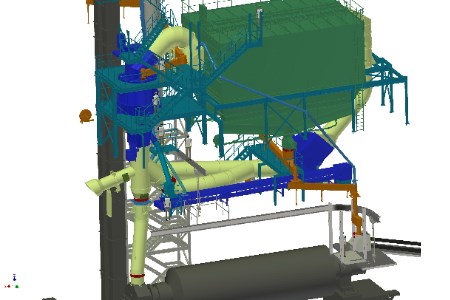Separating Success
Published by David Bizley,
Editor
World Cement,
Olaf Michelswirth, Intercem, explains how upgrading to high efficiency separators can improve grinding performance and product quality.

The improvement of grinding performance and quality is the target when employing separators in the cement mill circuit. Modern ball mills work in a closed circuit and this fact requires the high efficiency separation of fines and finished product in order to achieve satisfactory cement quality.
The main requirements for modern high efficiency separators are homogeneous grain size distribution and high precision in separation. Moreover, the production of different cement types in one grinding circuit has to be possible.
For Intercem, this market request – continuous quality increases for varying cement types – is very obvious and the company is working on a permanent steady increase of separator efficiency.
To meet these requirements, Intercem has developed a range of different classifier types:
- ICV – high efficiency vertical separator. Inflow of the process air including the mill dedusting air during cement separation via a process filter.
- ICS – high efficiency separator with tangentially-fed airflow and upper and lower bearing, accessible from outside for maintenance. For the separation of mill discharge material and cement separation via high efficiency cyclones or process filters.
- ICD vertical air separator with an installation example. For the use with (and optimisation of) vertical mills.
Functionality
At the top of the separator, there are two inlet feeding points. Here, the material gets into the separator. The mill discharge material will be fed to the top of the rotating cage and the distribution table, which has a special design that allows an optimised distribution of the separator feed to the separation cone. The material is led into the zone of dispersion which is situated between the rotor and the louvers. This is supported by the rotation of the cage.
A permanent feeding of the air sealing with confined air prevents oversized particles from entering the fine material flow and keeps the area between the sealing rings nearly clean of material.
In order to achieve the maximum lifetime, the sealing rings and the air sealing are made of wear-resistant material. The wear-resistant design of all internal separator parts assures a long lifetime without the necessity of maintenance. The sealing application is adjustable, thus enabling the sealing gap over long running operating hours.
With the aim of achieving an efficiency improvement, Intercem modified the system. The coarse cement should stay inside the separation zone as long as possible for the best possible deagglomeration of coarse and fine particles. This is achieved by material retaining devices in the separation zone. The impact against the cone of the wear-protected rotor results in the decomposition of agglomerates and the reduction of the size of bigger particles.
Coarse particles (grit) will be partially accelerated by the rotor, held by the guide vanes and discharged through the collector of the lower part of the separator which is protected by a homogeneous wear protection system.
The fineness of the product is adjusted by the speed of the rotor and the air velocity, whereas the air flow will be kept constant on design capacity for a wide range of cement qualities. Only for very fine qualities will the circulation air flow be reduced according to requirements.
It is of great importance that the width of the separation zone is adapted. The design of the rotating cage in-gate vanes and the air guide vanes of the stationed elements have a major influence as well.
A continuous improvement of the separator efficiency ensures the LTA (latest technology available) is used.
Enjoyed what you've read so far? Read the full article and the rest of the October Issue of World Cement by registering today for free!
Read the article online at: https://www.worldcement.com/special-reports/09102023/separating-success/
You might also like
Mitchell Plant hosts 2024 Tech Week
Heidelberg Materials North America hosts its annual Tech Week, where Cement Technical Services and Material Quality Control teams from across North America meet to learn about emerging trends and technologies.

